They say good things come to those who wait. Judges, prosecutors, law enforcement officials and others who spend their days in and out of courtrooms in San Diego waited more than a decade for a proposed new state courthouse to become reality. Most will agree the 25-story tower at the intersection of Union and C Read more
Featured Articles


Photo © Bruce Damonte
They say good things come to those who wait. Judges, prosecutors, law enforcement officials and others who spend their days in and out of courtrooms in San Diego waited more than a decade for a proposed new state courthouse to become reality. Most will agree the 25-story tower at the intersection of Union and C streets, which officially opened in December 2017, was worthy of their patience.
The 370-ft.-tall structure replaces a three-block-long, seven-story county courthouse that opened in 1961. Local and state officials initially proposed the project in 2004, but plans were put on hold until 2010. The new courthouse consolidates San Diego County’s criminal trial, family and civil courts into a facility that is loaded with high-tech features, including a radiant heating and cooling system that runs throughout the public corridors on each floor and the expansive, multi-use public space on the building’s first three floors.
“The intent was to make this the most sustainable project possible,” explains Steve Sobel, FAIA, managing director of Skidmore, Owings & Merrill LLP (SOM), the architectural firm that designed the courthouse. The courthouse earned a LEED® Silver certification.

The 704,000-sq.-ft. courthouse is expected to be used by more than 1.2 million people per year (approximately 4,000 per day). Sobel says the building’s transitional spaces—its airy multipurpose spaces on the first few floors, the hallways and elevator areas—are ideal for the energy-efficient REHAU radiant heating and cooling system. The building’s courtrooms, offices and other private areas, which are more enclosed and handle widely varying occupant loads, are heated and cooled with a traditional HVAC system.
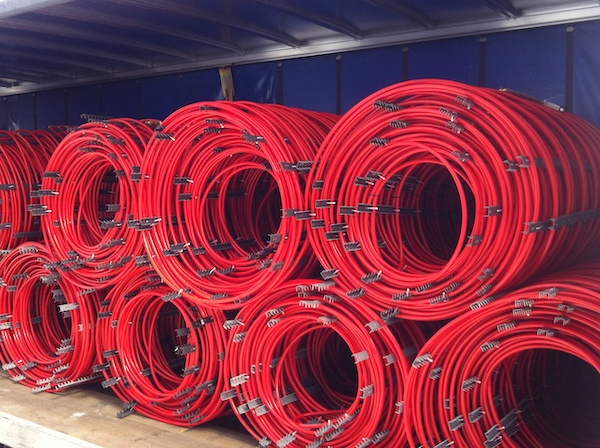
RAUMAT w/ RAUPEX O2 barrier pipe
SOM has used radiant heating in similar public spaces in lobbies, office buildings and other large spaces. The San Diego courthouse is one of the largest SOM projects in which radiant has been used. Approximately 112,000 ft (34,138 m) of 5/8-inch RAUPEX pipe runs through the courthouse carrying temperature-controlled fluid. For the floors that have an identical footprint, the pipe was preassembled on customized RAUMAT that was delivered in rolls, providing significant time and cost savings. Building chilled and hot water are mixed to appropriate temperature, depending on the operation (cooling or heating) of the radiant floors and zones.
“We looked at traditional HVAC systems for these spaces, chilled ceiling elements and chilled beams. In the end, [radiant] was the right system to use in these high-traffic areas,” Sobel says. The radiant system reduced the amount of duct space needed in the public areas (air ventilation is still preserved) and minimized concerns about coordinating between ducts with electrical and other infrastructure.
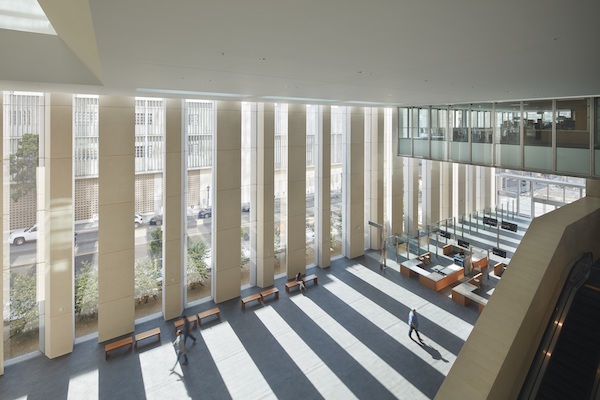
“We’ve done a lot of buildings with radiant floors. In these types of climates, they are really great systems,” says Ben Weerts, the lead mechanical engineer for the courthouse project. “Radiant makes the space really comfortable, especially when you’re dealing with large volumes of space. You don’t have to heat and cool the whole volume. You can just heat and cool the bottom strata where occupants are and it creates a comfortable environment,” he explains.
Project: San Diego Central Courthouse
Type of project: Municipal building, opened 2017
Scope of project: 112,000 ft (34,138 m) of RAUPEX pipe
Architect: Skidmore, Owings & Merrill LLP (SOM)
Mechanical Engineer: WSP
Mechanical Contractor: University Mechanical & Engineering Contractors
REHAU Systems Used: Radiant heating and cooling (RAUMATTM, RAUPEX® O2 barrier pipe, compression-sleeve fittings, PRO-BALANCE® manifolds)
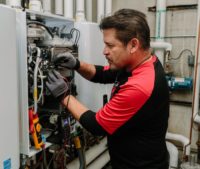
With an enrollment of more than 27,000 students, the University of New Mexico is the state’s largest college. It’s known for its strong and historied athletic programs, particularly the Lobos football and basketball teams, which compete in the Mountain West Conference. Dreamstyle Stadium has been home to the Lobos football team for 60 seasons. The Read more
With an enrollment of more than 27,000 students, the University of New Mexico is the state’s largest college. It’s known for its strong and historied athletic programs, particularly the Lobos football and basketball teams, which compete in the Mountain West Conference.
Dreamstyle Stadium has been home to the Lobos football team for 60 seasons. The 39,224 seat football stadium is attached to the L.F. Tow Diehm Athletic Facility. Tow Diehm, who’s known as the “Father of Athletic Training” in New Mexico, served as UNM’s athletics trainer for 31 years.
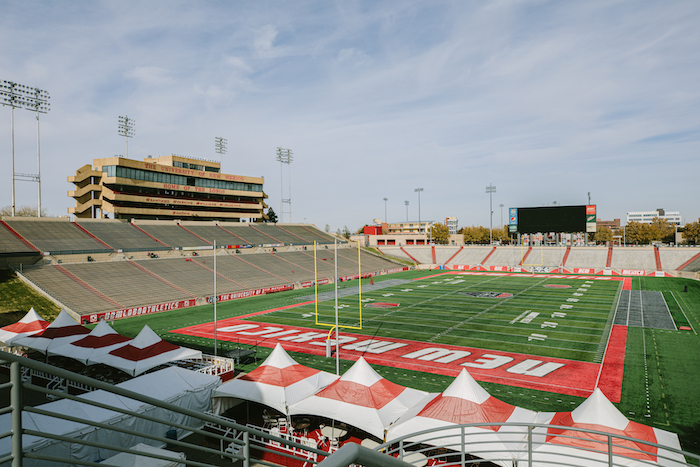
Inside, the facility includes athletic offices, common areas, locker rooms for both home and visiting teams, and a weight room that underwent an $800,000 renovation in 2014.
A more recent renovation took place in the facility’s primary mechanical room. Over the past few years, the domestic hot water system began failing. Nonstop pump failures, electrical problems, and a leaking hot water storage tank plagued maintenance crews.
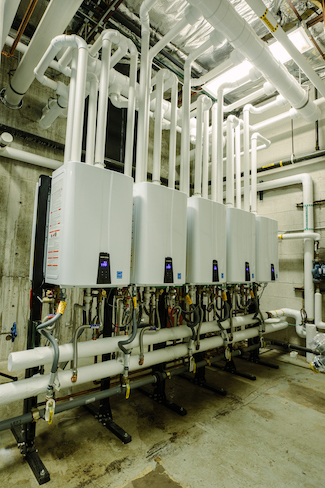 These problems inevitably surfaced at the worst times, like game day. The system provides hot water to all fixtures within the building, including the home and visitor locker room showers.
These problems inevitably surfaced at the worst times, like game day. The system provides hot water to all fixtures within the building, including the home and visitor locker room showers.
“We were frequently called in after hours to tend to the old system,” explained Richard Van Damme, HVAC master for the University of New Mexico. “At one point, we had even drained the 1,600 gallon storage tank for replacement, only to fill it again a few days later for game.”
Hot water was being supplied by two large, atmospheric volume water heaters with capacities of 490,000 BTUH each. The maintenance department had been pushing for replacement for a number of years. The cost of maintenance was rising, outright failure was imminent, the system’s dependability was lacking and efficiency was a concern.
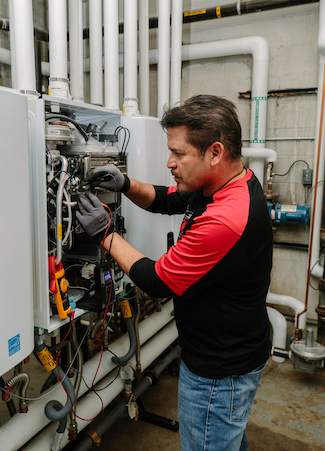
“When we received a work order to replace the failing system, we evaluated a straight, in-kind replacement with standard efficiency water heaters. Installing a similar storage tank would’ve required removing part of the roof. We also looked at tankless style system options. Energy savings was a big consideration, as was redundancy and serviceability,” said Jesse Hart, facilities engineer for UNM’s facilities management department.”
“There are short periods of high demand, with low or no demand otherwise,” he continued. “The showers aren’t even used year-round, so the application lent itself perfectly to a hi-efficiency, low-volume hot water system. Standby heat loss from the big tank was significant.”
UNM looked at various tankless products and contacted their local Navien representative, Jordan Mahboub, at RepNet. Mahboub and Hart worked closely with Navien sales engineers to create a design based on the peak hot water demand at the L.F. Tow Diehm Athletic Facility: 82 gallons per minute at 120F. The university wanted the ability to meet peak demand with one or two units offline.
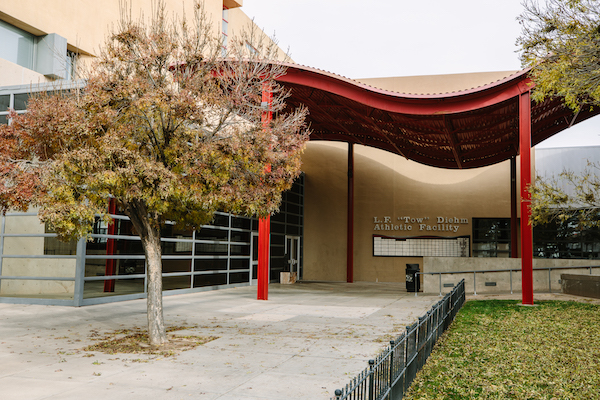
Once the design was approved, Futures Mechanical was hired for the replacement. The volume water heaters and storage tank were removed and 18 Navien NPE-240S condensing, tankless water heaters were installed.
The NPE-240S is a 199,900 BTUH condensing, wall-hung water heater that features dual stainless steel heat exchangers, a 10-to-1 turndown ratio, and efficiencies up to 97 percent. The unit also provides LEED points, where applicable.
Water heaters were installed in two independent systems, one on either side of the mechanical room to serve each locker room. Navien’s Ready-Link manifold system was used to simplify the installation and save space.
The Ready-Link Manifold System provides everything required for a multi-unit installation, including manifolds for water and gas, racks for floor mounting, valves, connections and flex lines.
Up to 16 NPE-240 units can be common vented, so only four roof penetrations were needed at the athletic facility.
“No intricate programming was needed to cascade this many units in a single system,” said Van Damme. “By using the factory-supplied cascade cable, the logic built into the units does all the thinking. If for some reason the master unit goes down, the next unit in line takes over, so there’s no downtime in the event of a unit failure.”
“Having Jordan Mahboub here during commissioning helped us learn all the advantages of the Navien system,” Van Damme continued. For example, each rack requires a single gas regulator, not every unit. The manifold system lets us isolate any unit in the group for service without taking the others off-line.”
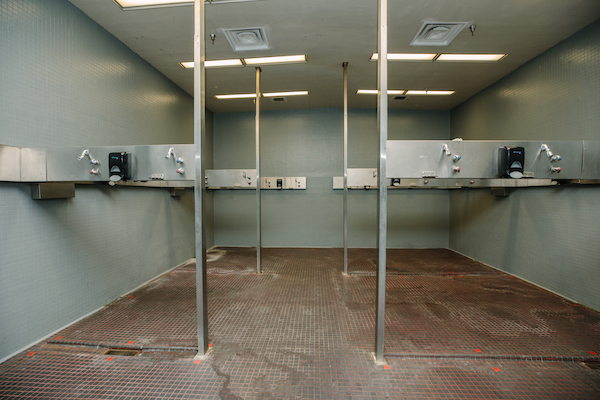
When the new system was tested, every hot water fixture in the facility was opened for almost two hours. The units cascaded to meet demand, but never fired to 100%. According to Van Damme, full capacity was met and sustained while the systems are operating at 60% input.
“The modulating component was a feature we really wanted,” Hart said. “Each of these units provides a 10-to-1 turndown, so no matter if there’s one sink or 20 showers running, we can accurately match the load. We’re not using energy beyond what’s needed to meet the actual demand. Now that the system has been operational for over a year, we’ve found an annual natural gas savings of 2,282 Therms.”
The entire project took three months over the 2018 summer break. The installation was seamless, and was completed just in time for football season. There’s now more space to service the water heaters or work on other equipment within the room.
“I think this system is a great asset to the stadium,” Van Damme said. “The money saved on maintenance alone is significant. We’ve been so impressed with these units that we’ve decided to use Navien systems in other locations across campus.”
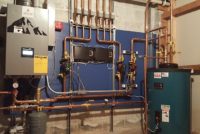
Quarryville, PA, is home to a true hydronic savant. Tom Soukup, owner of Patriot Water Heater, Co., used to do general plumbing and a variety of HVAC work. However, over the past few years, he has transitioned to a sole focus on hydronic work. “Hydronic heating—and cooling for that matter—is a truly universal form of Read more
Quarryville, PA, is home to a true hydronic savant. Tom Soukup, owner of Patriot Water Heater, Co., used to do general plumbing and a variety of HVAC work. However, over the past few years, he has transitioned to a sole focus on hydronic work.
“Hydronic heating—and cooling for that matter—is a truly universal form of space conditioning,” exclaimed Soukup. “What other medium has as much ability, and flexibility? I can heat your building, your spa, your DHW, melt snow, create process water, and just about anything else. And I can do it with nearly any fuel source you can think of.”
Soukup has done hydronic work since he got his start in the trades 25 years ago. Still, his recent move to all hydronic has been so deliberate that he even created a new brand, EcoDronics.
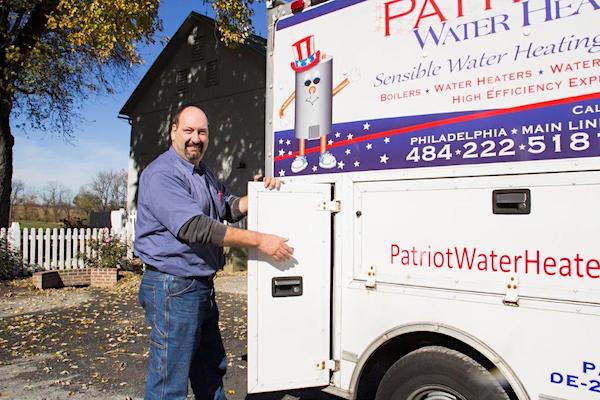
Tom Soukup, president of Patriot Water Heater, arrives to a jobsite.
“EcoDronics is our ‘unconventional’ hydronic brand,” he explained. “Think greenhouses, swimming pools, and snowmelt. It’s different than general home comfort, so the new brand reflects that.”
The move into unique water-based heating applications doesn’t mean that the company turns down typical boiler projects. Last month, a nearby homeowner asked Soukup to give a second opinion on a dying mechanical system.
Patriot Water Heater’s answer was the same as the first company that visited the home: a complete system replacement of the LP-fired boiler system was needed. The difference is how Soukup came to the conclusion, and the results he could deliver throughout the home, not just the boiler room.
“I make a point to spend a good deal of time asking what the customer wants in regard to the system as whole,” he said. “Noise, comfort, control… and whether or not there areas of the house that go unused? I need to know what the homeowner really wants so my team can deliver it.”
Murphy’s Law
This customer’s system was 25 years old, and it’s a wonder it lasted that long. Anything that could have been installed wrong, had been.
“There was no primary/secondary piping, no air elimination, no feed valve and the pump was on the return side of the boiler,” said Soukup. “The water returning to the cast iron boiler was too cool and the heat exchanger was condensing. The combustion chamber had collapsed, sections were leaking, the flue pipe was rotten, oil use cost over $3,000 per year, and the home was horribly uncomfortable. Long piping runs and high head pressures created by strange piping were causing both condensation and comfort issues.”
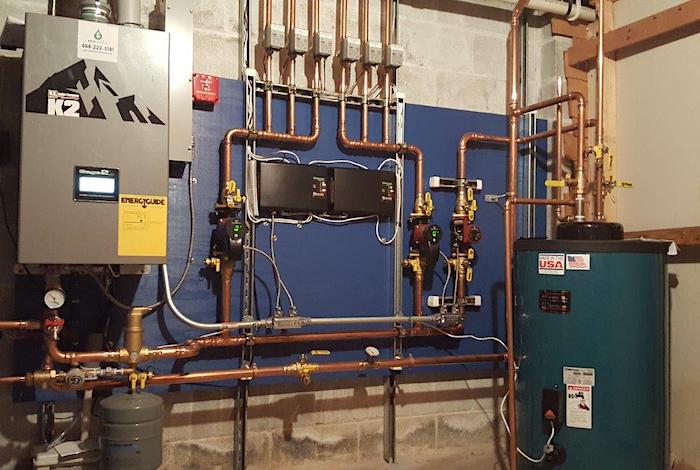
Soukup appreciates that U.S. Boiler Company provides a full hydronic solution: K2 boiler, Sage Zone Controls and the Alliance sidearm tank. A boiler with a 10-1 turndown ratio is complemented nicely by variable-speed pumps, making the system very responsive to the needs of the home.
The house was zoned horizontally, right down the center, instead of being zoned upstairs and downstairs. The upstairs was sweltering hot while downstairs occupants froze. The parents ran an electric space heater in their downstairs bedroom so that the kids, upstairs, wouldn’t sweat all night.
When the first contractor visited the home, they condemned the boiler but had no interest in addressing the comfort issues, or how the fin-tube radiation had been piped.
“My apprentice and I spent 16 hours analyzing and diagnosing issues before we gave a bid,” said Soukup. “First we performed a Manual J and an EDR. It became apparent that scrapping the boiler and rebuilding the mechanical room was the easy part. Rezoning the house was another story.”
Rubber meets road
Over the course of four days, Patriot Water Heater completely revolutionized the heating system. Aside from the baseboard and some copper pipe, everything was replaced.
“As is usually the case when you think things through before grabbing a pipe cutter, the install was relatively straightforward,” said Soukup
He and his apprentice, Ben Dyson, installed a K2 condensing boiler made by U.S. Boiler Company. The unit features a 10-1 turndown and provides 95% AFUE. They also used two U.S. Boiler Sage Zone Controls, which are expandable to 16 zones.
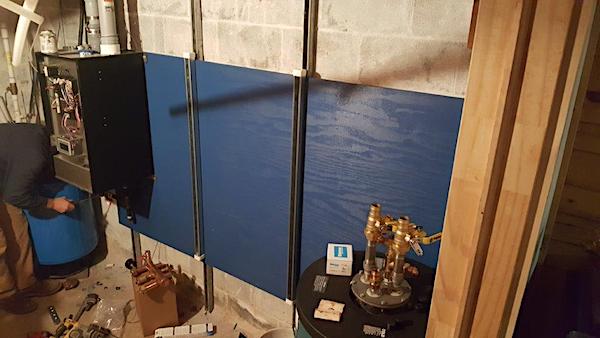
Patriot sets the big items first: K2 boiler and Alliance SL indirect tank.
“U.S. Boiler hit a home run with the K2 boiler,” said Soukup. “It’s a ton of functionality in a small box, and the controls are lightyears ahead of the competition. For example, the Sage Zone Control communicates directly with the boiler. I think being able to provide an integrated solution is important.”
Soukup and Dyson, who is a Marine reservist, broke the existing supply and return piping into six zones. A seventh was added for domestic hot water. A 35-gallon U.S. Boiler Alliance SL tank was used for nearly limitless hot water, long service, and the fact that the tank features top connections. The existing electric water heater was removed.
Fine-tuned success
“I visited the home on the morning after I fired the boiler, and the customer mentioned how nice it was to have even heat throughout the house,” said Soukup. “At the time, the outdoor temperature was 31°F and the boiler was running at 20% input. Nonetheless, there was still a little room for improvement.”
Through the K2 boiler’s touchscreen display, Soukup accessed the zone-by-zone runtime data and noticed that the living room was calling for heat too often. So, he lowered the anticipated BTUs slightly on the Sage Zone Control, and set the programmable thermostat’s temperature differential from one to two degrees. That solved the issue, and comfort levels haven’t changed.
“That’s what I love about the Sage Controls,” said Soukup. “Once I program the control, I can get really granular by looking at individual parts of the system. It allows me to fine-tune the system. Plus, if you’re going to install a modulating boiler, isn’t that the ultimate goal?”
On commercial projects specifically, Soukup has begun installing a meter on the gas valves of the systems we will be retrofitting, sometimes a year in advance. It’s a fantastic way to compare the energy use before and after a retrofit, and he can use those concrete numbers to sell the next project.
“For residential jobs like this—which don’t typically provide us with enough data collection time on the front end—we use the owner’s records,” explained Soukup.
On this job, the owners knew they’d used 2,200 gallons of fuel oil (308,000 MBH) the previous year. The year following the retrofit required 800 gallons of LP gas (73,600 MBH). Those number don’t include DHW production, either, as DHW had previously been supplied by electric, and are now provided by the boiler via the sidearm tank. And an electric space heater is no longer used in the master bedroom.
That’s a staggering improvement, but at the end of a cold winter day, it is pretty hard to quantify comfort.
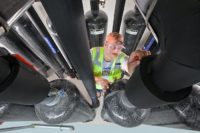
By Jana Summey A few months after the “reopening” of the economy, understandably, business owners and government officials welcomed a return to normalcy. However, new and different risks are faced when reopening dormant buildings with stagnant water systems. Several weeks of zero flow, low flow, and tempered water can result in microbiological growth, leeching heavy Read more
By Jana Summey
A few months after the “reopening” of the economy, understandably, business owners and government officials welcomed a return to normalcy. However, new and different risks are faced when reopening dormant buildings with stagnant water systems.
Several weeks of zero flow, low flow, and tempered water can result in microbiological growth, leeching heavy metals, and corrosion within our plumbing systems.
Planning is key
Let’s take a close look at steps building facility managers should consider in order to maintain water quality and safety in plumbing systems of unused or slightly used buildings (as defined by industry organizations including NSF International, Centers for Disease Control and Prevention (CDC), and the International Association of Plumbing & Mechanical Officials (IAPMO).
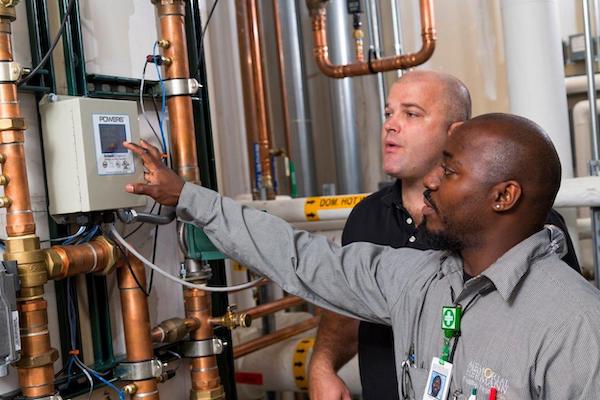
The IntelliStation digital water mixing system delivers mixed hot water throughout a hot water recirculation loop in commercial and institutional facilities. This digital solution can be integrated into a building automation system (BAS) to allow facilities managers to remotely monitor and control water temperatures.
Begin by documenting protection measures for staff and visitors. Consider working with a water quality expert or consultant. And, ask the local water utility the following questions:
- Have there been any recent water supply disruptions?
- Have standard checkpoints been inspected?
- What is the current disinfectant concentration?
If one isn’t already in place, create a map of the building’s plumbing system.
Before the initial flush, sketch out the building water system to identify low-use water outlets. Map out a flushing regimen in a unidirectional process starting at the water supply’s point-of-entry, to the peripheral distalpoints, and point-of-use outlets such as faucets and showerheads.
In large buildings, the water supply is often designed in zones and branches, such as different wings. Typically, each wing or set of branches will be served by the same riser. When mapping out the plumbing system, always start from the outlet nearest the water supply and proceed to the most distal outlets. Along this route, the flushing regimen should include the entire recirculating loop, both cold and hot water, all associated equipment and appliances, and all outlets including faucets, showerheads, eye wash stations, ice machines, hot tubs, therapy pools, and water features.
Establish or reestablish a flushing and cleaning regimen. Flushing is important because it clears out the low-quality water that accumulated during low use and replaces it with high-quality water from the municipal supply. The fresh water helps mitigate loss of protective scale as well as biofilm growth that emerged while the water was stagnant.
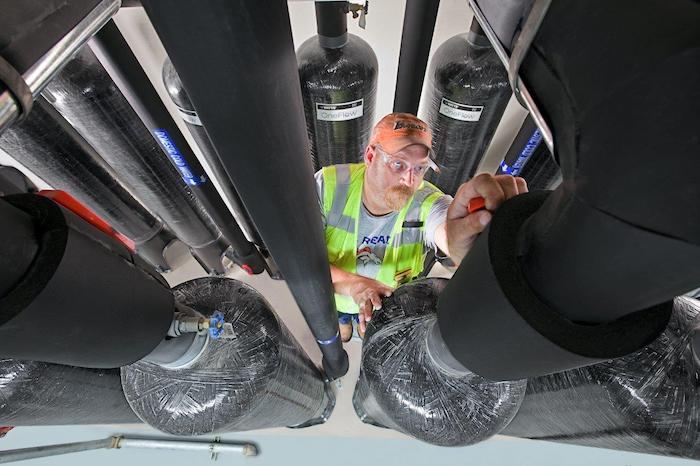
After the initial flush, ongoing flushes should be scheduled; continual flushes help to repair destabilized scale and minimize biofilm growth. Watts’ OneFlow System, shown here, uses a specially designed media where scale forming molecules are transformed into harmless crystals that won’t stick to pipes and components, eliminating scale for good.
These conditions need to be addressed because they proliferate the growth of Legionella and other waterborne pathogens, creating a high-risk environment for those with compromised immune systems. Proper flushing is a multi-step process including an initial flush, sequenced flushing, cleaning of fixtures and equipment, testing and monitoring, and additional flushing as needed.
Initial flushing and cleaning must be completed before resuming normal building operations. The sooner flushing is begun, the better. If possible, have staff start flushing now, even if the building’s reopening date is still unknown. The earlier a flushing regimen is initiated, the sooner water quality will return to normal. Prior to flushing, appropriate training for staff should be completed and PPE (personal protective equipment) should be provided. Guidance for this can be found on OSHA’s website.
It’s vital to flush the entire piping system from point-of-entry to point-of-use. This includes all water outlets, utility sinks, hose taps, piping currently used, as well as piping and fixtures in place for future installations. However, it doesn’t hurt to take special notice to the parts of the water system that have the greatest opportunity to make people sick. These include:
- Faucets used for drinking water or food preparation
- Drinking fountains
- Ice machines and refrigerators with ice makers
- Showers
- Kitchen sink sprayers
- Water features that generate aerosols (fountains, spas, etc.)
- Parts of the water system used by children, the elderly, and other susceptible people
An initial flush clears out contaminants that accumulated during stagnation and draws in fresh, high-quality water to the piping. Cleaning the fixtures removes contaminants from the complex internal structures at the point of discharge. Flushing requires an initial flush to get out low-quality water and contaminants, and follow up flushes that may bring the building back to pre-COVID-19 water quality. Ongoing flushing draws particles through and out of the system and brings in disinfectant from the municipal system that can help control biological growth. The longer service is interrupted, the more effort will be required for restoration.
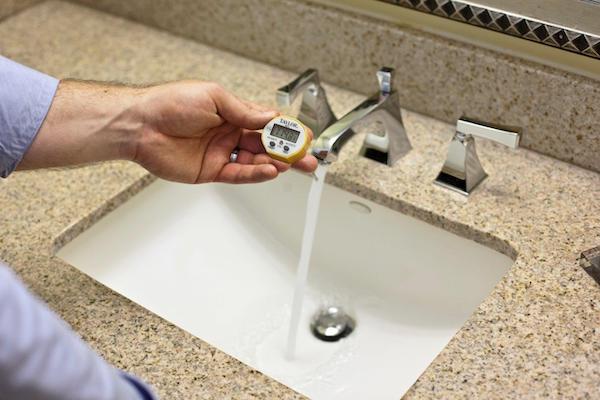
Once the building is reopened, conduct normal process of ensuring tempering valves are maintaining the desired temperature.
Flush zone by zone, starting with the zone closest to the water building supply. In each zone, start with the cold water plumbing first, followed by the hot water. Within the zone, open taps starting with the outlet closest to the zone origin, working toward the farthest point. Flushing should not end until the farthest point-of-use tap has flushed for a minimum of five minutes, and the cold water temperature at the most distal tap is constant.
In order for flushing to be most effective, consider the following:
- All valves should be in a fully opened position during the entire flushing process
- All aerators should be removed. If continued use is planned, clean or replace the screens prior to reinstalling the aerators
- Showerheads and faucets should be disinfected and sterilized. Consider replacing outlets if vulnerable populations have access
- Prior to operating the system after flushing, adjust valves back to normal operating positions
As part of the flush, all locations where water is stored should be identified, drained, and flushed with clean cold water. Examples include humidifiers, ice machines, and dishwashers. Most buildings have some form of water treatment in their plumbing system such as filters and water softeners. These should run as normal, be included in the flush, and should not be bypassed.
Once flow has returned after this initial flush, all hot water tanks should be drained. Temperature should be maintained, and the heater should not be turned off. Continual operation is important to prevent microorganisms from growing. Make sure that water heat storage temperature are sufficient to kill bacteria (131 to 140°F).
After the initial flush, ongoing flushes should be scheduled; continual flushes help to repair destabilized scale and minimize biofilm growth. The American Water Works Association (AWWA) recommends continued flushing for a minimum of 12 weeks. This allows the protective scale to re-stabilize and for harmful lead particles to be washed through the plumbing system.
Recommendations for ongoing flushes include:
- Open each point-of-use tap at least once per day
- Flush the entire building once per week during ongoing flushing
- It is not necessary to drain water storage during ongoing flushing
- Continue to flush the cold and hot water systems separately; cold first, hot second
Monitoring and testing
Monitoring and testing should start for Legionella, other bacteria growth, and disinfectant levels prior to the initial flush, throughout the ongoing flushing, and on a predetermined schedule going forward. Monitoring and testing are the only ways to know the health of the plumbing system.
At the end of the initial flush, disinfectant levels should be checked. The concentration level of chlorine, the most commonly used disinfectant, should be measured at the point-of-entry and in the cold water of the most distant tap of each zone after the tap is flushed. Comparison of the point-of-entry concentration to the distal tap concentration will give an indication of the protection being provided to the entire plumbing system.
If other disinfectants are used, such as monochloramine, be sure to measure and compare its concentration at point-of-entry and distal outlets. Water temperature should be regularly tested and recorded.
The system should be tested for Legionella by a certified laboratory. Many facilities will choose to work with a consultant for this process. Samples should be collected at least 48 hours after final flushing and return of normal operation of the water system. Multiple samples should be collected to ensure accuracy and prevent false negative results. Samples should be taken at multiple locations throughout the system, from point-of-entry to point-of-use.
Hyperchlorination or shock disinfection should be conducted if testing proves unacceptable levels of Legionella. This is where a higher than normal level of chlorine is flushed through the plumbing system for a specific length of time, and the water temperature is raised for rapid kill. The cold water system should be flushed from point-of-entry to point-of-use, including all fixtures. The water should reach a CT of no less than 3,000 mg-min/L. “CT” value is the concentration of disinfectant and contact time with the water being disinfected.
Systems that have high levels of Legionella, or are known to have heavy biofilm, may require even higher CT targets. Higher chlorine dosage may allow for shorter disinfection contact times. Always take proper precautions to ensure there is no inadvertent exposure to occupants. Strict access controls should be in place. Conduct testing to ensure chlorine levels are in normal ranges at the conclusion of treatment. When hyperchlorination is complete, the system should go through an additional thermal flushing.
Even if unacceptable Legionella levels are not found after thermal flushing, hyperchlorination should still be considered, especially in buildings where high risk or immune compromised populations could be exposed.
Following, adjusting, and creating a water management plan
A facility management team should record all monitoring and testing practices including the frequency, locations, and results. If there is a water management plan, those findings should be integrated into the record keeping portion of the plan. If a water management plan does not exist, we strongly encouraged the creation of one. Most healthcare facilities are required under the Centers for Medicare & Medicaid (CMS) mandate to have a water management plan. Failing to do so can cause a facility to lose Medicaid and Medicare reimbursements.
Implementing a water management plan as outlined in ASHRAE 188 will help maintain a high-quality level in a building. The Centers for Disease Control (CDC) has developed a water management plan toolkit based on ASHRAE 188. The toolkit aids in the understanding of risk levels of different building types and devices and walks step by step through the requirements of a healthy water management plan.
Maintenance and Recommissioning
As part of the process of reopening a building, all mechanical equipment should be inspected. Examples include cooling towers, boilers, pumps, backflow preventers and digital mixing stations. Essentially, the water systems and equipment should be recommissioned as if it were a new building. Make sure any scheduled maintenance that may have been missed during building closings are completed and recorded in accordance with normal practices.
Some general guidelines include:
Digital thermostatic mixing
During/before closing
- Drain the piping system prior to closing if planning for a long-term building closure
- If draining the system isn’t an option, increase production and storage of hot water above 150° F, and keep the building pump running at full temperature by bypassing a TMV or setting the DMV to full hot
- Conduct a periodic purge of all dead legs to keep the system reasonably clean
At reopening
- Conduct either a high temperature water purge, hyperchlorination shock, or both
- Generally, calibration of mixing valves is not needed
- Once the building is reopened, conduct normal process of ensuring tempering valves are maintaining the desired temperature
Backflow
- Conduct a visual inspection
- If the water supply was completely shut off and the pressure decreased, all reduced pressure zone units need to be repressurized correctly, and the relief valve should be closed
- All pressure breaker valves also need to be repressurized correctly and the relief valve should be closed.
- The pressure breaker valve should be spill resistant, but it should still be checked
Gas connectors
- Assuming equipment has been turned off, a device such as FloPro™-MD can assist with a startup check to ensure each piece is operating at manufacturer’s specification
- Verify proper gas supply to any gas burning appliance with a BTU rating of 325,000 BTU’s or less, whether it is in a commercial kitchen or not
Drainage systems
- For general drains, there are no special requirements. However, a visual inspection should be part of the reopening plan
Stainless steel piping and drainage systems
- Other than the absence of water in the traps from either back siphonage or evaporation, stainless steel piping systems require no special considerations when being returned to full service after periods of non-use
- Stainless steel pipe and fittings are resistant to corrosion caused by decomposition of organic matter and the subsequent formation of hydrogen sulfide gas or microbiologically-influenced corrosion
Rainwater harvesting
- Purge the system via the hose bibs or flush out the system by opening the flush valves to create a steady flow of water
- Check the tanks to ensure the aerator is functioning and the inlet pre-filter is in service
Water quality solutions
For most water quality devices, it is a good idea to flush the unit. However, it’s always best to consult manufacturer guidelines for each device.
UV systems
- Inspect to ensure the light is working correctly
- Check to make sure any scheduled maintenance wasn’t missed
- Visually inspect the vessel
Sediment/point-of-entry filtration
- Visually inspect
- Clean any clogs and replace filters when needed
Point-of-use filters
- Visually inspect
- Clean any clogs and replace filters when needed
- Check to make sure any scheduled maintenance wasn’t missed
Measuring instrumentation
- In measuring instruments such as the CIX Instrument from HF scientific (chlorine measurement), there is a potential for reagents to crystallize in the tubes if there is a sudden loss of power or power is off for an extended time
- During inspection, in the rare event that crystallization has occurred, the unit needs to be primed and reagents replaced
Snow melt
- The snow/ice detector should be cleaned with soap and water
- Inspect the control display to ensure there are no error messages due to faulty sensors
Water Heaters
- Determine if the manufacturer recommends draining the water heater after a prolonged period of non-use
- Ensure that all maintenance activities are carried out by professionals or according to the manufacturer’s instructions
- Make sure the water heater is set to at least 122°F and consider higher temperatures (131°F -140°F) for a quicker kill
- Ensure that measures are taken to prevent scalding if the water heater is set to >130°F
- Wipe down the outside and control with disinfectant
- Conduct proper startup by authorized service agent
- Conduct a significant blowdown of all components
- Check combustion and calibration, perform all safety device testing, and verify all system operating parameters are correct and functioning
Additional Equipment to Be Inspected:
Hot tubs, spas, therapy pools
- Check for existing guidelines from local or state regulatory agency(ies) before opening for use
- Visually inspect for slime and biofilm prior to refilling
- Perform a hot tub/spa disinfection procedure before use per CDC guidance
Cooling towers
- Revisit startup and shutdown procedures
- Follow manufacturer guidelines and industry best practices
- Visually inspect for slime and biofilm prior to use
- Assuming the cooling tower has been well maintained, proceed with disinfection procedures. Guidance can be found from the Cooling Technology Institute: http://www.cti.org/downloads/WTP-148.pdf
Maintaining system after reopening
Planned and detail cleaning should be part of the reopening process. This includes proper maintenance of all equipment and fixtures, and the replacement of filters from point-of-entry to point-of-use. Be sure to follow manufacturer guidelines and contact the proper authorities when necessary.
Twenty-four hours before reopening the building, it’s recommended to conduct a round of checks. Bring the hot water system back up to 140° F. Open all outlets and flush until they reach a minimum of 131° F. After flushing, conduct a final round of sampling to ensure there is no contamination.
Once the building has resumed normal operation and the water system is back to standard function, the main priority will be maintaining water system quality and safety. If there is no water management plan prior to the disruption, create one immediately. This should include a schedule for monitoring and testing disinfectants, bacteria levels, and water temperature. Follow the plan, document activities, and adjust as needed. If an issue arises, promptly address it and notify authorities if deemed necessary.
If the building is scheduled to reopen within one month, continue a normal control regimen if possible. If the time to reopen the building is unknown, or if its scheduled to reopen longer than 1 month away, there are precautions that can be taken during that time to increase water quality prior to pre-open flushing and chlorination.
Consider the following:
- Conduct low-usage weekly maintenance
- Conduct weekly visual inspections
- Initiate operation of moving parts such as pumps for at least 10 minutes per week to prevent seizure and failure
- Increase water temperature to 140° F for at least 1 hour per week to reduce bacteria growth
- If equipment such as a water heater has a thermal sterilization cycle, utilize it per manufacturer recommendations
- Maintain normal disinfectant levels
- Flush outlets on a weekly basis
- Ensure all storage maintains proper disinfectant levels
- Document all activity, monitoring, and testing
- If it is decided to close certain systems, drain and dry if possible
If the decision has been made to not heat water within the plumbing system during closure, then consider the following:
- Close the building and do not drain the system
- Turn off storage tanks, drain, and the water supply
- Consider conducting thermal flushing and hyperchlorination prior to shutdown
If a building is not being fully shut down but will be under low-use conditions, consider the following options to maintain the system:
- Flush cold water systems on a regular schedule to maintain temperature and disinfectant. Free chlorine residual should be at or above .2 mg/L
- Monitor and maintain the hot water system at distal outlets
- Monitor and record supply water temperature and disinfectant concentration
- Restrict access to any unused portions of the building
- Document all monitoring, testing, and maintenance
Additional Resources
There are a multitude of tools and guidance to assist in maximizing water safety and minimizing water risks when preparing to reopen an unused or slightly used building:
- CDC Toolkit: https://www.cdc.gov/legionella/wmp/toolkit/index.html
- Preventing Legionnaires’ Disease: A Training on Legionella Water Management Programs: https://www.cdc.gov/nceh/ehs/elearn/prevent-LD-training
- Hotel Guidance: Considerations for Hotel Owners and Managers: How to Prevent Legionnaires’ Disease: https://www.cdc.gov/legionella/wmp/hotel-owners-managers.html
- From Plumbing to Patients: https://www.cdc.gov/hai/prevent/environment/water.html
- Preventing Occupational Exposure to Legionella: https://www.cdc.gov/niosh/docs/wp-solutions/2019-131/default.html
- CDC Model Aquatic Health Code
- CDC Healthcare Water System Repair and Recovery Following a Boil Water Advisory or Disruption of Water Supply
- ASHRAE Standard 188: Legionellosis Risk Management for Building Water Systems
- ASHRAE Guideline 12: Minimizing the Risk of Legionellosis Associated with Building Water Systems
- Cooling Technology Institute Legionellosis Guideline 2008 (WTP-148)
- Cooling Technology Institute Legionellosis Guideline 2019 (GLD 159)
Learn more about ensuring safety in commercial buildings by mitigating the risk of Legionella and other waterborne bacteria at www.legionella-strategies.com.
 Jana Summey, MBA, Watts Healthcare Vertical Market Manager, has nearly 20 years’ experience in the MEP (mechanical/electrical/plumbing) design and architectural design industries. She is a popular speaker on mitigating Legionella through a multi-barrier approach in on-premise plumbing systems – from point of source to tap. Recently Jana navigated her mother through the experience of being exposed to Legionnaires’ as a hospital patient, gaining valuable insight into the serious threat Legionella poses for at-risk populations.
Jana Summey, MBA, Watts Healthcare Vertical Market Manager, has nearly 20 years’ experience in the MEP (mechanical/electrical/plumbing) design and architectural design industries. She is a popular speaker on mitigating Legionella through a multi-barrier approach in on-premise plumbing systems – from point of source to tap. Recently Jana navigated her mother through the experience of being exposed to Legionnaires’ as a hospital patient, gaining valuable insight into the serious threat Legionella poses for at-risk populations.
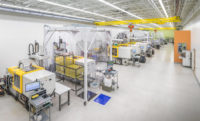
BY JOHN O’REILLY Circle Pines, a Minnesota-based injection-molding company, more than doubles its vendor report card score in only two years by aggressively boosting its performance in energy conservation, packaging materials, health and safety audits, and other areas. Few things in this world can be factually characterized as truly “unique”—as in “one of a kind,” Read more
BY JOHN O’REILLY
Circle Pines, a Minnesota-based injection-molding company, more than doubles its vendor report card score in only two years by aggressively boosting its performance in energy conservation, packaging materials, health and safety audits, and other areas.
Few things in this world can be factually characterized as truly “unique”—as in “one of a kind,” “nothing like it anywhere else.” But for Eric Eichten, “unique” is an absolutely spot-on summation of the three-year-old Uponor Sustainability Report Card questionnaire process.
“We have had customers who’ve required this sort of vendor survey maybe one time—like when we are just starting a relationship,” says Eichten, who serves as customer relations lead at Advanced Molding Technologies (AMT) in Circle Pines, Minn. “But for the most part, sustainability has been almost an afterthought. The focus Uponor has devoted to sustainability—and the value their management ascribes to it year-in and year-out—is not something I have seen elsewhere.”A plastic-injection molder, AMT has been supplying Uponor engineered plastic pipe fittings for use in the latter’s crosslinked polyethylene (PEX) piping systems for more than two decades. In fact, AMT founder and owner Brett Nelson previously worked with Uponor (then known as “Wirsbo”) at another vendor before launching AMT in 1999.
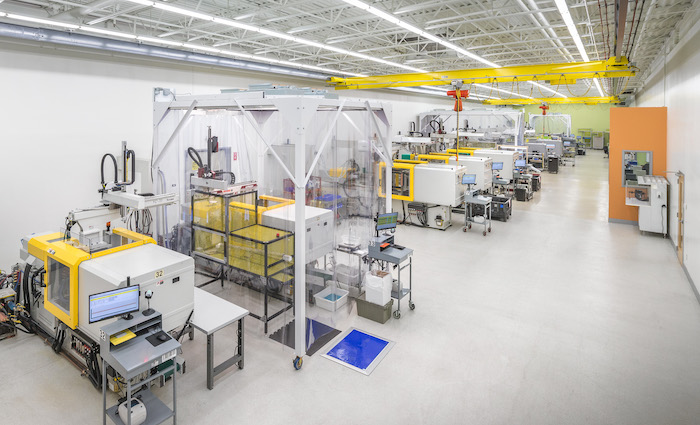
Press room: AMT injection molding presses on the company’s molding floor.
Uponor Engineered Polymers category manager Loren Boerboom, whose Supply Chain team works with Eichten, describes AMT as a “very sophisticated company and a strong supplier. Technology-wise, they are top notch, and they adhere to our demanding standards for fittings.”
Nonetheless, three years ago, when AMT management received the inaugural version of the now-annual sustainability questionnaire, it came as a bit of a jolt, recalls Eichten. “I don’t know that ‘surprised’ is the right word, but I can’t say we were expecting all the questions it asked. The survey was an eye-opening experience, to say the least.”
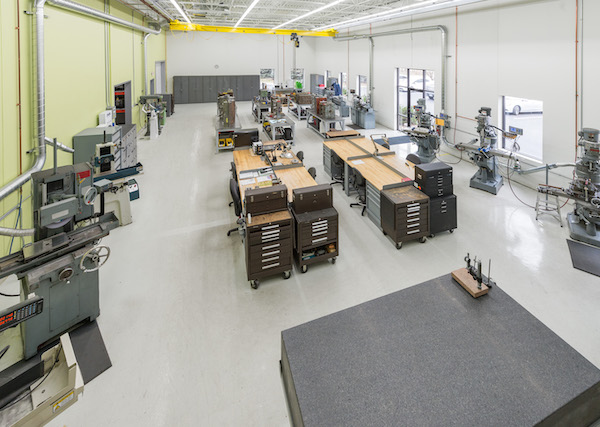
Tool room: Where AMT’s injection molds are cleaned and maintained for customers.
That first year, 2017, AMT earned 12 points out of a possible 53 on the 23-question form, earning a “C rank.” The next year, the company more than doubled its total to 25 (again out of 53), raising its rank to “B.” (Survey questions are kept the same from year to the next, “so that we are comparing ‘apples to apples,’” says Boerboom.) In 2019, AMT increased its point total again, to 27, further bolstering its “B” rank.
Rather than regarding that first questionnaire as an imposition—let alone an abuse of the leverage a buyer might hold over a long-time supplier—AMT quickly embraced the process as “motivational,” according to Eichten. “The Uponor survey has shown us where exactly we need work, where we could improve.”
Proactive approach
What most impressed Boerboom and the other members of his team was the proactive manner in which AMT used its survey results to pursue internal improvements. “They actively reached out to our company, holding meetings with our sustainability people to get ideas: ‘What can we do to align with Uponor when it comes to sustainability?’”
Over the past three years, AMT has achieved improvements in numerous areas, but three are particularly notable:
- Corporate social responsibility (CSR): In 2017, AMT had no formal, written CSR or sustainability policy. Led by its CEO and the company’s human resources department, AMT built one from scratch in 2017-2018, generating five additional points on the second survey.
“We want to be a great injection-molding company,” says Eichten, who has worked at AMT the past seven years, five of them on the Uponor account. “When we had to answer that question ‘no’ in 2017, we also recognized it as a huge opportunity to improve. Brett and our HR people worked the better part of a year on the new statement,” which now lives in the company’s employee handbook.”
- Reductions in energy consumption: In AMT’s injection-molding process, large amounts of energy are expended heating the tool. An ongoing problem was the amount of heat lost during the process: Cut that heat-loss total, and a significant amount of energy could be saved.
“To reduce heat loss, we added insulator plates where we have a steel tool sitting on top of the steel platen of an injection-molding machine,” explains Eichten. “So, instead of heating the machine, most of the heat is now concentrated by the insulator on the molding tool.”
Although it is difficult to quantify the precise energy savings, Eichten estimates that this simple move to insulation has had a substantial, positive impact. “We believe that it saves us roughly 30 minutes at the startup of a tool,” he explains. “Then, over the course of a production run, we need less energy to maintain a set temperature in that tool.”
- Reductions in packaging materials and shipping distances: AMT maintains approximately 80,000 square feet under roof in two buildings located cater-corner to one another in Circle Pines. Injection molding is done in one facility; packaging, the other. Bulk product movement between the two is done with large, palleted and—here’s the key—reusable plastic cartons, called “gaylords,” the name of their manufacturer.
“The plastic pallets are filled at our production facility,” says Eichten, “and the contents are transported to the second building for packaging, while the gaylords return to the first building for repeat refilling. We use the same cartons over and over.”
“Long way to go”
AMT management recognizes that much of the “low-hanging fruit” in process improvement has already been plucked, and that future improvement projects will be larger, perhaps more complicated, and most likely more costly. As an example, Eichten points to replacing more than 80,000 square feet of fluorescent lighting in the two facilities.
“We want to substitute LED lights, and that is a much larger, more costly and difficult process to tackle,” he continues. “But the LED switch may also have greater impact in the long run in terms of energy savings.”
In its aggressive move to embrace sustainability, AMT “still has a long way to go,” Eichten concedes. “We are aware of a lot of large projects out there that we definitely want to complete. But we are also looking forward to taking those next steps.”
